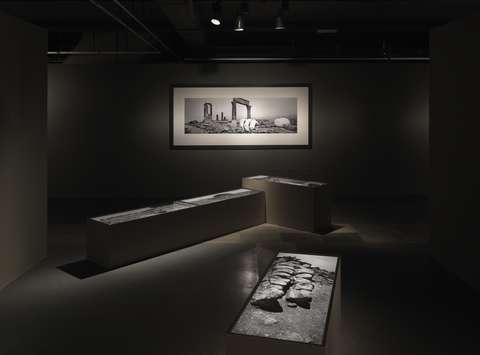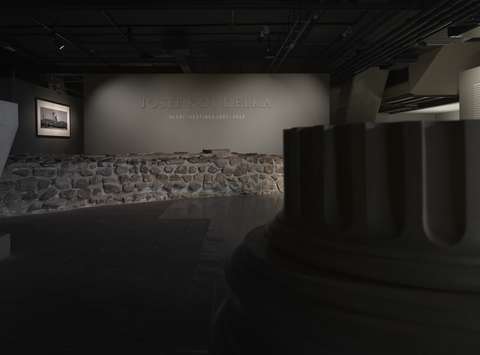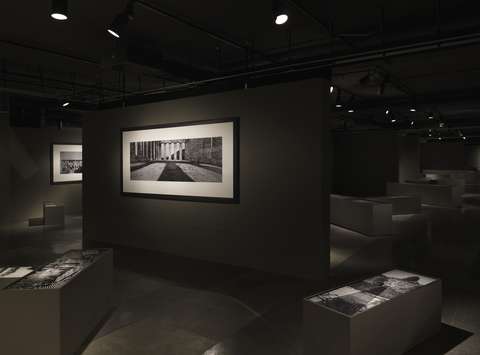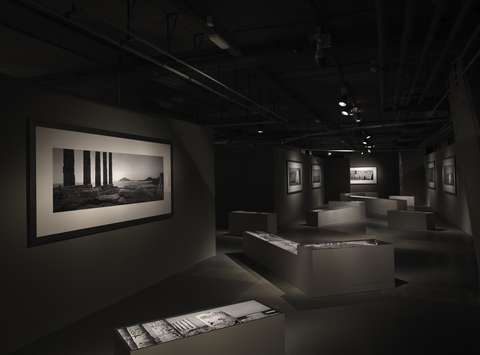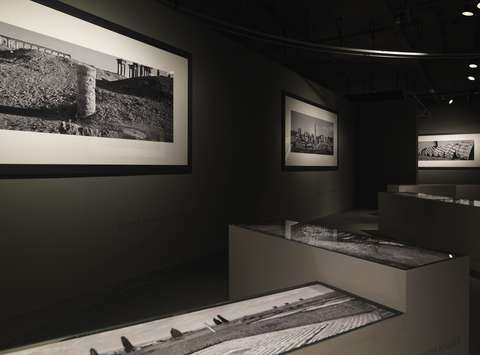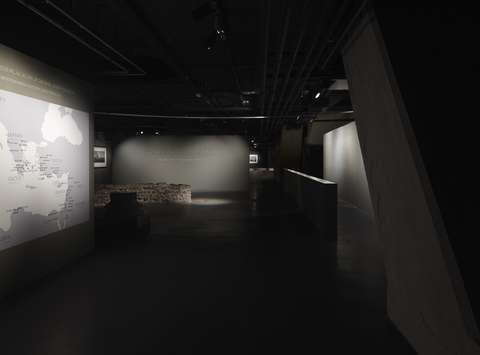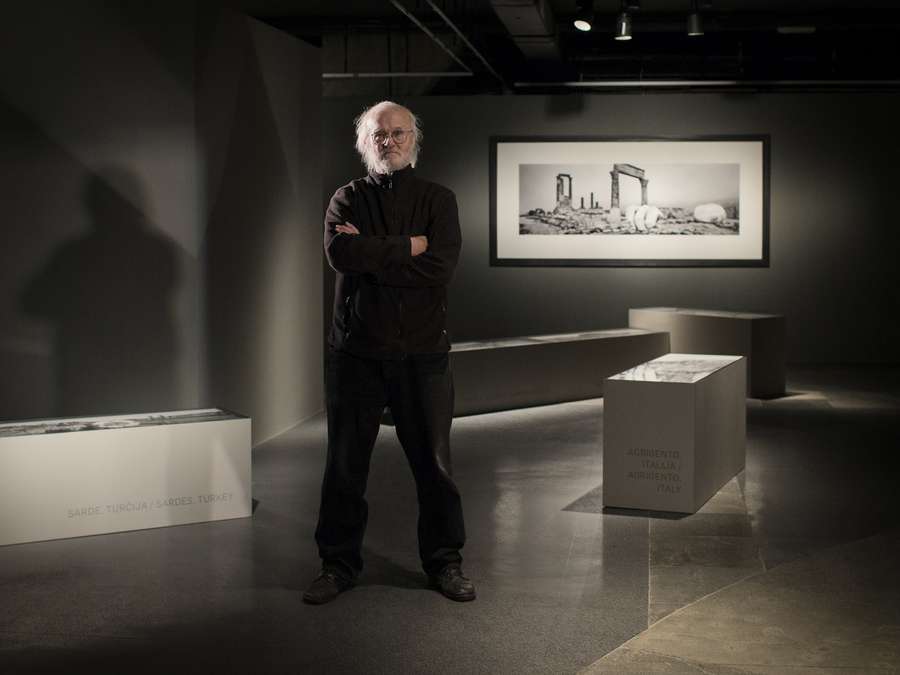Josef Koudelka: Vestiges / Sledi 1991–2012
Josef Koudelka, one of the world’s most acknowledged masters of photography, a member of Magnum Photos and the winner of prestigious photography prizes, who has to date shown his work in major centres of photography and contemporary art around the world, is presented in Slovenia for the first time at the Jakopič Gallery.
According to the curator Marija Skočir, Vestiges / Sledi 1991–2012 is an exhibition comprising monumental black-and-white panoramic photographs taken by Josef Koudelka during the mentioned time span in 19 countries by the Mediterranean Sea while he was visiting over 200 ancient Greek and Roman archaeological sites. The exhibition offers an insight into a unique and intimate research journey which has not yet come to an end: Koudelka continues to visit archaeological sites in Greece, Turkey, Tunis, Algeria, Syria, Jordan, Egypt, Lebanon and other Mediterranean countries where he, displaying limitless perseverance and requiring little help, documents ruins from a different, entirely individual vantage point. In his photographs, Koudelka preserves the world we are leaving behind and losing sight of. However, he does not do this as a photojournalist nor is he driven by a wish to create documentary photographs. Koudelka records monuments, those mighty traces of man’s activity, in periods of the day which allow them to appear in their innermost essence and in the complete absence of any live presence around them. The images convey the photographer’s experience of the monologue conveyed by the silence of the ruins, inviting the viewer to enter through the photographs into this world of glorious witnesses of the past.
The photographs are taken with a panoramic camera, an item employed by Josef Koudelka ever since 1986 when he participated in the DATAR photographic mission. He later also used it during the Transmanche expedition and in projects such as Chaos. It is only in the last few years that the artist has been using a digital camera adjusted to the panoramic format.
The exhibition in the Jakopič Gallery innovatively presents the photographs as spatial elements positioned on the gallery floor, i.e. embedded in a pattern marking the layout of the ancient Emonan buildings that once stood at the site of the present-day gallery. Making visitors feel as if they are strolling through archaeological remains, they highlight both horizontal and vertical lines deriving from the structural elements of the squares, fora, cities, buildings and building elements of ancient civilisations. Arranged in this way, the photographs interact with the large panoramic photographs hanging on the gallery walls. After viewing these, visitors can observe a projection of 300 photographs which cannot yet be put on display. The projection complements the photographer’s journey which has still not come to an end, with the artist not being aware of the true impulse that makes him return to the same places time and again: "Basically, what dominates is an attraction to beauty, the solitude in beauty – a beauty that encourages and feeds reflection. It’s this beauty that has attracted me for the past 21 years, and leads me to visit the same places several times. Each time I try and capture the place better than I did on the previous visit."
The focus is also on book publications which account for a significant part of the artist’s work, thereby rounding off the insight into his brilliant career as a photographer. Visitors are able to flip through some of Koudelka’s fundamental photo monographs. As an introduction to the exhibition, there is a display case containing the Teatro del Tempo monograph which presents one detail of a topic that is more extensive yet similar to Vestiges: in it, Koudelka has published photographs of archaeological remains and patterns created by landscapes and buildings taken between 2000 and 2003 in the Eternal City of Rome, where they were later put on display as part of the FotoGrafia festival.
Since the Vestiges project has not yet finished, the exhibition has no catalogue. However, the Jakopič Gallery, in co-operation with the photographer, has published a boutique volume designed and printed in Slovenia at an extremely affordable price containing 20 key photographs of the Vestiges 1991−2012 series, which should not be missing from the bookshelves of any true collector of Josef Koudelka’s publications.
The exhibition is on display within the framework of the Month of Photography 2014 and the pan-city project Emona 2000.
ABOUT THE ARTIST
Josef Koudelka was born in Moravia, Czechoslovakia, in 1938. After having first photographed theatre performances and the life of the Roma parallel to his life as an aeronautical engineer, Koudelka became a full-time photographer in 1967.
In August 1968, he took photographs of the Soviet troops invading Prague and putting an end to the Prague Spring. His images were published abroad anonymously, only signed with the initials P. P. (Prague Photographer). In 1970, he left his country and became stateless, living in England until 1979 and becoming a French citizen in 1987. He only returned to his country of birth in 1990. In 1974, he became a member of Magnum Photos and established friendships with Henri Cartier-Bresson and Robert Delpire. In co-operation with the latter, the Gypsies photography monograph was first published in 1975. The following decades saw the publishing in books of several other of Koudelka’s photographic series, among them Exiles (1988), Chaos (2000), Invasion Prague 68 (2008) and Lime (2012).
As early as in 1975, an important exhibition of his work took place at the New York Museum of Modern Art (MoMA). Since then, he has had solo exhibitions in major centres of photography and contemporary art around the world, including at the International Center of Photography in New York, Hayward Gallery in London, the Stedelijk Museum in Amsterdam, the Palais de Tokyo in Paris and many other venues around the world; in 2013, he participated in the Venice Biennial following an invitation to present the Holy See.
He is currently preparing two retrospective shows at the Art Institute of Chicago and Getty Museum in Los Angeles.He has won many awards: an award from the Union of Czechoslovakian Artists in 1967, the Robert Capa Gold Medal Award in 1969 as the anonymous photographer "P. P.", the Prix Nadar in 1978, the Grand Prix National de la Photographie in 1987, the Henri Cartier-Bresson Award in 1991 and the Hasselblad Award in the following year. He has been a member of the Berlin Academy of Arts since 2009. He lives between Paris and Prague, incessantly travelling and photographing.
The "Josef Koudelka: Sledi / Vestiges 1991–2012" exhibition is accompanied by a publication with twenty reproductions of Koudelka’s photographs. Josef Koudelka is one of the world’s most acknowledged masters of ...
Colophon
Production: Museum and Galleries of Ljubljana
Photographer: Josef Koudelka
Curator: Marija Skočir
In collaboration with: Magnum Photos
Graphic and exhibition design: Bojan Lazarevič - Agora Proars
Realisation of the exhibition: Technical Service MGML, O.K.vir
The project was made possible by: City of Ljubljana, Ministry of Culture of the Republic of Slovenia
Location
Slovenska cesta 9
1000 Ljubljana
T +386 1 42 54 096
T +386 1 24 12 500
E galerija.jakopic@mgml.si
Opening hours
Tuesday–Sunday: 10 a.m.-6 p.m.
Monday: Closed
1 January, 1 November, 25 December: Closed
24 and 31 December: 10. a.m.-2 p.m.
Tickets
Adults: 5 €
Students, people over the age of 60, unemployed, people with disabilities: 3 €
Family ticket: 12 €
ICOM, PRESS, SMD, students of the Academy of Fine Arts and Design, VIST – Higher School of Applied Sciences, Faculty of Natural Sciences and Engineering – OTGO, Faculty of Design: Admission free
Guided tours of the exhibition: every Saturday at 4.30 p.m. (included in the admission fee)
Join the Friends of the Jakopič Gallery. The € 12 annual membership fee includes numerous benefits and exclusive events. Click here for more information.
